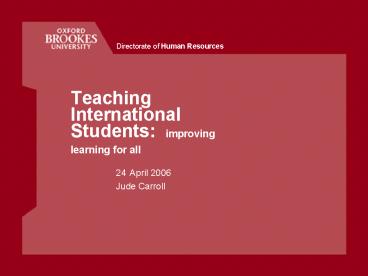Teaching International Students: improving learning for all PowerPoint PPT Presentation
1 / 17
Title: Teaching International Students: improving learning for all
1
Teaching International Students improving
learning for all
- April 2006
- Jude Carroll
2
What helps?
- Recognising differences in academic cultures
- Identifying the skills students need to succeed
helping those without develop those skills - Support and guidance for ISs before, at the
start, during study - Support and guidance for all students in
cross-cultural communication - Changes in teaching methods to encourage
participation by all - Paying special attention to problem areas
3
New game, new rules
- All students find University hard at first
- Some find it hard and strange.
- Some .hard, strange and in a new language
- A few hard, strange, in English and
unacceptably wrong. - Nearly all succeed
4
Rooted in academic culture assumptions
- What do I call teachers?
- What present should I give the teacher?
- What am I supposed to be doing when Im not in
class? - What counts as good work? gets good marks?
- Whats a seminar and what happens there?
- How much reading do I have to do?
- How will I ever manage British academic writing?
- What am I supposed to learn from lectures?
5
New game, old rules .What kinds of
surprises would you expect to see?What would you
notice ISs doing that you would not expect in a
UK student?
6
Explicit about academic culture
- Assessment
- Teaching methods (purpose, behaviour expected,
how it contributes to learning) - Writing and reading
- Relationships and expectations of teachers
7
curriculum overt and hidden
- Content
- Methods and activities
- Students experience
- Everything linked to teaching, learning and
assessment that a student might encounter at any
time in their HE career that derives from the
university.. - Question what in the curriculum might need to
change to accommodate the needs of an
increasingly diverse student body and to
encourage a genuinely internationalised
university experience?
8
Internationalisation.what and why?
- . ..fostering global understanding and
developing skills for effective living and
working in a diverse world ethos - operating in international surroundings, under
international market conditions an
international professional orientation
activity - integrating an international/intercultural
dimension into the teaching, research and service
of the institution content - graduates solving problems in a variety of
locations with cultural and environmental
sensitivity competency
9
Internationalisation a process
- Why move?
- In what direction? By doing what?
- How will that look here, locally, in my
classroom? Our programme? Our discipline?
10
Rationales for encouraging cross-border education
/ internationalisation OECD (2004)
- Mutual understanding
- Skilled migration
- (ensuring graduates stay in the host country as
long term support to the knowledge economy) - Revenue generating
- Capacity building
- (using others HE provision where local demands
outstrip supply) - (not mutually exclusive)
11
.mean by internationalisation?
- What would an internationalised curriculum look
like - in different disciplines?
- at the level of individual courses?
- in teaching and learning practices?
- How would internationalisation operate at the
level of - individual teachers?
- courses and programmes?
- departments?
- the university as a whole?
- What activities need to underpin a
university-wide strategy for internationalisation?
12
Back to What helps? identifying skills
- Early diagnostic activities in the discipline
area - Co-ordinated efforts between specialists and
discipline-specific teachers - Showing students examples of good practice,
teacher feedback on good and poor practice - Early structure and get busy requirements for
the first few weeks
13
Front-ended support
- Realistic expectations of induction
- Early diagnostic tasks and activities
- Teach skills by doing, not by explaining
- Provide safe practice and feedback
- More structure than later on..
14
Early English strategies
- Tensions and troubles get focused around English
- High IELTS scores . but unready for real
English or academic writing - Extra needs around academic writing, especially
if IELTS below 7.0
15
Lighter language load
- Plain English
- Straightforward language (common word,
subject-verb-object sentences, plain texts) - Finishing words
- Avoiding jargon, jokes and metaphors
- Using non-yes checking strategies
16
Every student likes.
- Pre-warning and pre-reading
- Handouts and gapped notes
- Allowing tape recording
- In seminars, rehearsal in pairs before telling
whole group - Native-tongue discussion of ideas
- Early, safe feedback on academic writing
- Grammar buddies
- Creating a running glossary of discipline-specific
terms - Less thinking about process so more thinking
about content
17
methods to encourage participation
- by not allowing the fast talking, confident ones
to dominate.. - Ensure students know each other and know what
they can get from each other - Provide warning and rehearsal
- Model inclusion
- Use structured discussion formats

